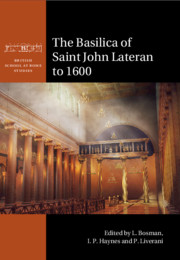Book contents
- The Basilica of Saint John Lateran to 1600
- British School at Rome Studies
- The Basilica of Saint John Lateran to 1600
- Copyright page
- Contents
- Figures
- Contributors
- Acknowledgements
- Abbreviations
- 1 The Lateran Basilica to 1600
- 2 The Evolution of the Lateran: From the Domus to the Episcopal Complex
- 3 At the Foot of the Lateran Hill, from Via Sannio to Viale Ipponio: Archaeological Investigations Prior to the Construction of Metro Line C
- 4 Ground-Penetrating Radar Survey in the Saint John Lateran Basilica Complex
- 5 The First Residential Phases of the Lateran Area and a Hypothesis to Explain the So-Called Trapezoidal Building
- 6 The Castra Nova and the Severan Transformation of Rome
- 7 Andrea Busiri Vici and the Excavations of 1876: A Reassessment of the Archaeological Evidence
- 8 Visualising the Constantinian Basilica
- 9 Constantine’s Spolia: A Set of Columns for San Giovanni in Laterano and the Arch of Constantine in Rome
- 10 The Constantinian Basilica in the Early Medieval Liber Pontificalis
- 11 The Lateran Baptistery in the Fourth and Fifth Centuries: New Certainties and Unresolved Questions
- 12 The Nymphaeum of Pope Hilarus
- 13 Examples of Medieval Construction Techniques in the Basilica of San Giovanni in Laterano
- 14 The Medieval Portico of Saint John Lateran
- 15 MATER ET CAPUT OMNIUM ECCLESIARUM: Visual Strategies in the Rivalry between San Giovanni in Laterano and San Pietro in Vaticano
- 16 The Remodelling of San Giovanni in Laterano by Pope Nicholas IV: Transept, Apse and Façade
- 17 Furtum Sacrilegum: The ‘Holy Heads’ of Peter and Paul and Their Reliquaries in the Lateran
- 18 Reconsidering the Traces of Gentile da Fabriano and Pisanello in the Lateran Basilica
- 19 The Rite of the Reconciliation of Penitents at the Lateran Basilica
- 20 The New Passion Relics at the Lateran, Fifteenth to Sixteenth Centuries: A Translocated Sacred Topography
- 21 The East Façade of the Complex of Saint John Lateran in the Modern Era
- 22 The Book of Acts in the Constantinian Basilica: Cardinal Cesare Baronio and the Navata Clementina in San Giovanni in Laterano
- Bibliography
- Index
17 - Furtum Sacrilegum: The ‘Holy Heads’ of Peter and Paul and Their Reliquaries in the Lateran
Published online by Cambridge University Press: 27 August 2020
- The Basilica of Saint John Lateran to 1600
- British School at Rome Studies
- The Basilica of Saint John Lateran to 1600
- Copyright page
- Contents
- Figures
- Contributors
- Acknowledgements
- Abbreviations
- 1 The Lateran Basilica to 1600
- 2 The Evolution of the Lateran: From the Domus to the Episcopal Complex
- 3 At the Foot of the Lateran Hill, from Via Sannio to Viale Ipponio: Archaeological Investigations Prior to the Construction of Metro Line C
- 4 Ground-Penetrating Radar Survey in the Saint John Lateran Basilica Complex
- 5 The First Residential Phases of the Lateran Area and a Hypothesis to Explain the So-Called Trapezoidal Building
- 6 The Castra Nova and the Severan Transformation of Rome
- 7 Andrea Busiri Vici and the Excavations of 1876: A Reassessment of the Archaeological Evidence
- 8 Visualising the Constantinian Basilica
- 9 Constantine’s Spolia: A Set of Columns for San Giovanni in Laterano and the Arch of Constantine in Rome
- 10 The Constantinian Basilica in the Early Medieval Liber Pontificalis
- 11 The Lateran Baptistery in the Fourth and Fifth Centuries: New Certainties and Unresolved Questions
- 12 The Nymphaeum of Pope Hilarus
- 13 Examples of Medieval Construction Techniques in the Basilica of San Giovanni in Laterano
- 14 The Medieval Portico of Saint John Lateran
- 15 MATER ET CAPUT OMNIUM ECCLESIARUM: Visual Strategies in the Rivalry between San Giovanni in Laterano and San Pietro in Vaticano
- 16 The Remodelling of San Giovanni in Laterano by Pope Nicholas IV: Transept, Apse and Façade
- 17 Furtum Sacrilegum: The ‘Holy Heads’ of Peter and Paul and Their Reliquaries in the Lateran
- 18 Reconsidering the Traces of Gentile da Fabriano and Pisanello in the Lateran Basilica
- 19 The Rite of the Reconciliation of Penitents at the Lateran Basilica
- 20 The New Passion Relics at the Lateran, Fifteenth to Sixteenth Centuries: A Translocated Sacred Topography
- 21 The East Façade of the Complex of Saint John Lateran in the Modern Era
- 22 The Book of Acts in the Constantinian Basilica: Cardinal Cesare Baronio and the Navata Clementina in San Giovanni in Laterano
- Bibliography
- Index
Summary
The “Holy Heads” of Peter and Paul, attested in the 11th century within a secondary altar of the Laurentius-Oratory in the Patriarchium Lateranense and later on inside the main altar of the Sancta Sanctorum, increased their status exponentially after having been transferred by Pope Urban V (1368-70) into the Lateran Basilica. Embedded in two huge, lavishly decorated anthropomorphic reliquaries they were enclosed high up in the new tabernacle above the main altar of the Cathedral of Rome. The new mise-en-scène emphasized their role as symbols of the double apostolicity of Rome and of the Roman Church restored after the return of the Papacy from Avignon. In the late 14th and15th Century the Capita apostolorum became one of the most prestigious relics in Rome in competition with the Veronica at the Vatican. The skulls of Peter and Paul in their precious containers – displayed only few times a year – attracted not only pilgrims, but also thieves. A lost fresco cycle in the transept painted shortly after the attempt to steal some jewels and gems from their reliquaries at Easter 1438 should have deterred potential thieves with its representation of the cruel punishments inflicted on the alleged culprits.
- Type
- Chapter
- Information
- The Basilica of Saint John Lateran to 1600 , pp. 345 - 378Publisher: Cambridge University PressPrint publication year: 2020



